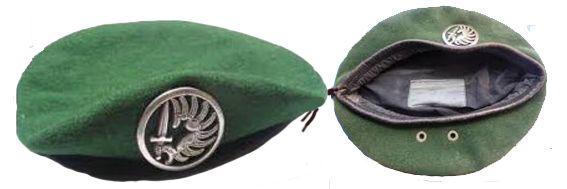Green Beret of the Legion.
First and foremost, this text is not intended to fuel controversy or challenge institutional decisions regarding the symbols of the Foreign Legion. It is intended, above all, as a historical and memorial reflection on an emblem that, over the decades, has acquired a symbolic significance far beyond its simple uniform.
The green beret is a powerful marker of identity, tradition, and sacrifice. Evoking its history means evoking the journey of generations of legionnaires, both French and foreign, who have contributed to building its legend. This is therefore not about judging contemporary usage, but rather about recalling the profound meaning and origins of this symbol, forged through hardship and combat.
May the reader read these lines with respect for those who wore this beret on the battlefield, but also with understanding for the natural evolution of a vibrant institution, made up of men, women, and memory.
Here is its story, between legend, honor, and controversy.
Louis Perez y Cid
Green Beret of the Legion:
An insignia born in blood, fought for in honor
By Lt. Col. (TE.ER) Antoine Marquet
Black, blue, amaranth, green… In the panoply of French military berets, each color tells a story, a weapon, a tradition. But only one crystallizes a myth and controversies that affect its deepest meaning: the green beret of the Foreign Legion.
An emblem forged in adversity
The epic journey of the green beret was not without its challenges. As early as 1949, in Indochina, the paratrooper legionnaires demanded the amaranth beret, the badge of the French paratroopers. The high command refused, issuing a categorical veto. It was during this conflict, "in the sweat and blood" of combat, that the green beret emerged, almost smuggled. The 1st BEP opposed it. Its adoption was like a forceps delivery.
It wasn't until 1957 that it became widespread throughout the Legion, with the paratroopers distinguishing themselves by the famous "winged right-hander" insignia rather than the seven-flame grenade. A symbol of the elite, it was always awarded sparingly: to young recruits without insignia before the white kepi was awarded, or to certain specialists in other branches on specific missions.
In Indochina, the auxiliaries who fought alongside the Legion were only entitled to a white beret. The green one was the prerogative of the legionnaire.
The contemporary controversy: who is entitled to the sacred beret?
This history of sacrifice gives the green beret an almost sacred aura. As a result, the sight of it on some heads today is considered an offense by former legionnaires, and perhaps even by active legionnaires.
What do we see? Reservists who never served in a Legion regiment now wear it. Even more symbolic: a woman, an archivist or curator at the Legion Museum in Aubagne, also dons it. Although a cadet and a graduate of the Army, she has never entered a recruiting office or experienced life on a "Farm" in Castelnaudary, where the soul of a legionnaire is, in part, forged. The question then arises with stark acuity: has this beret, earned in the mud of the battlefield, become a mere uniform accessory, or does it remain the ultimate marker of a unique affiliation, cemented by unwavering commitment and specific training?
Why shouldn't the woman who embodies the memory of the Legion wear the attributes of her original weapon, rather than the most sacred insignia of a family in which she was neither incorporated nor trained?
PS- The female personnel of the SEPP (Parachute Maintenance and Folding Section) assigned to the 2nd REP in Calvi come from non-Legion parachute units. In uniform, they wear the red beret.



